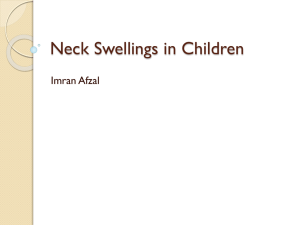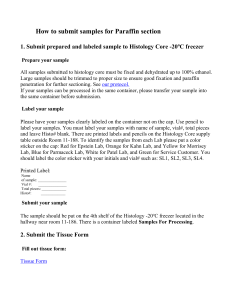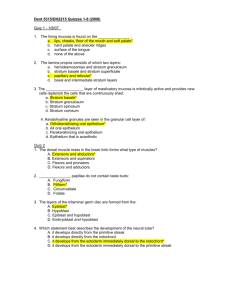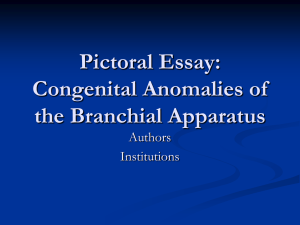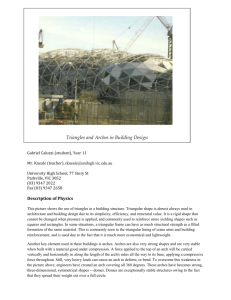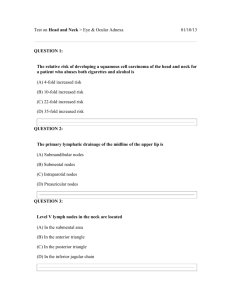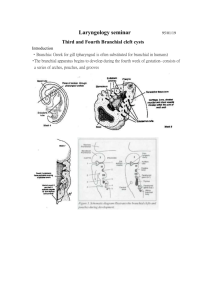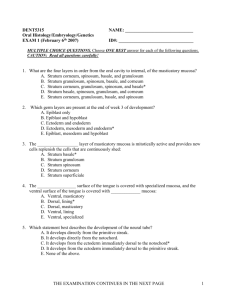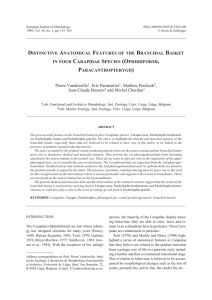embryologie_atmungssystem
advertisement
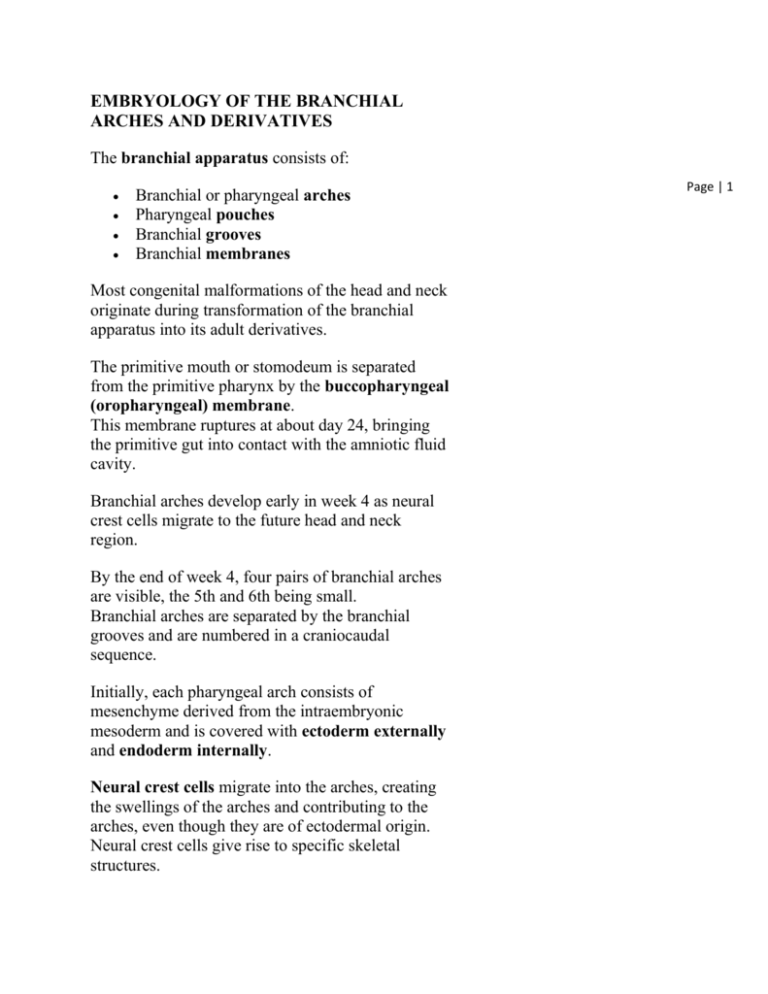
EMBRYOLOGY OF THE BRANCHIAL ARCHES AND DERIVATIVES The branchial apparatus consists of: Branchial or pharyngeal arches Pharyngeal pouches Branchial grooves Branchial membranes Most congenital malformations of the head and neck originate during transformation of the branchial apparatus into its adult derivatives. The primitive mouth or stomodeum is separated from the primitive pharynx by the buccopharyngeal (oropharyngeal) membrane. This membrane ruptures at about day 24, bringing the primitive gut into contact with the amniotic fluid cavity. Branchial arches develop early in week 4 as neural crest cells migrate to the future head and neck region. By the end of week 4, four pairs of branchial arches are visible, the 5th and 6th being small. Branchial arches are separated by the branchial grooves and are numbered in a craniocaudal sequence. Initially, each pharyngeal arch consists of mesenchyme derived from the intraembryonic mesoderm and is covered with ectoderm externally and endoderm internally. Neural crest cells migrate into the arches, creating the swellings of the arches and contributing to the arches, even though they are of ectodermal origin. Neural crest cells give rise to specific skeletal structures. Page | 1 The mesenchyme in the arches give rise to muscles. A typical branchial arch contains: an aortic arch a cartilaginous rod a nerve a muscular component Derivatives of the branchial arch cartilage 1st branchial (mandibular) arch cartilage develops : into malleus and incus (middle ear bones) from its dorsal portion into the anterior ligament of the malleus and the sphenomandibular ligament from the perichondrium of its intermediate portion into the primordium of the mandible from its ventral portion 2nd branchial (hyoid) arch cartilage develops: into the stapes (middle ear) and the styloid process from its dorsal part into the stylohyoid ligament from the perichondrium of its intermediate part into the lesser cornu and the superior part of the hyoid bone from its ventral part 3rd branchial arch cartilage develops into the greater cornu and inferior part of the body of the hyoid bone. 4th and 6th branchial arch cartilages fuse to form the laryngeal cartilages, except for the epiglottis which forms from the mesenchyme in the hypobranchial eminence (from the 3rd and 4th branchial arches). Page | 2 Derivative of the branchial arch nerves 1st branchial arch: Trigeminal (V) nerve (maxillary and mandibular divisions only) 2nd branchial arch: Facial (VII) nerve 3rd branchial arch: Glossopharyngeal (IX) nerve 4th and 6th branchial arches: Vagus (X) nerve Derivatives of the branchial arch muscles 1st branchial arch: Muscles of mastication Mylohyoid and anterior belly of the digastric Tensor tympani Tensor veli palatini 2nd branchial arch Muscles of facial expression Stapedius Stylohoid Posterior belly of the digastric 3rd branchial arch Stylopharyngeus 4th and 6th branchial arches: Cricothyroid Levator veli palatini Constrictors of the pharynx Intrinsic muscles of the larynx Striated muscles of the esophagus Pharyngeal pouches develop between the branchial arches (1st pouch is found between the first and Page | 3 second branchial arches). There are 4 pairs, the 5th is absent or very small. The endoderm of the pharyngeal pouches and the ectoderm of the branchial grooves contact each other to form the branchial membranes separating the pharyngeal pouches and the branchial grooves. Derivatives of the pharyngeal pouches 1st pharyngeal pouch expands into a tubotympanic recess The expanded distal portion of the recess contacts the 1st branchial groove (this is the only branchial membrane to persist in the adult) contributing to the formation of the tympanic membrane or eardrum. Only the 1st branchial groove persists in the adult as the external acoustic meatus The tubotympanic recess gives rise to the tympanic cavity and the mastoid antrum. Connection between the tubotympanic recess and the pharynx elongates to form the auditory tube. 2nd pharyngeal pouch contributes to the formation of the palatine tonsil and the epithelial lining of the fauces. 3rd pharyngeal pouch contributes to the formation of the inferior parathyroid glands (week 5- bulbar portion) and the thymus (elongate portion). which migrate inferiorly (past the superior parathyroid glands of the 4th pouch). 4th pharyngeal pouch contributes to the formation of the superior parathyroid gland (bulbar portion) and the parafollicular cells or calcitonin cells of the thyroid gland (elongate portion - ultimobranchial body). Page | 4 RESPIRATORY EMBRYOLOGY The lower respiratory system (from the pharynx down) develops during week 4 (26-27 days) starts as a median laryngotracheal groove in the caudoventral wall of the primitive pharynx. The endoderm lining the groove gives rise to the epithelium and glands of the larynx, trachea, bronchi and the pulmonary epithelium. Connective tissue, cartilage and smooth muscle of these structures develop from the splanchnic mesenchyme surrounding the foregut. The laryngotracheal groove deepens into a diverticulum ventrally which enlarges distally into a lung bud. The diverticulum becomes separated from the primitive pharynx by longitudinal trachoesophageal folds which fuse to form the trachoesophageal septum, dividing the foregut into the ventral laryngotracheal tube and the dorsal esophagus. A fistula may exist connecting trachea and esophagus and resulting in abnormal communication between the two. This is usually associated with superior esophageal atresia. In a newborn infant, this is associated with coughing and choking upon swallowing. Gastric contents may reflux into the trachea and lungs resulting in pneumonia or pneumonitis (inflammation of the lungs). An excess of amniotic fluid (polyhydramnios) is associated with Page | 5 esophageal atresia and trachoesophageal fistula because amniotic fluid may not pass to the stomach and intestines for absorption and transfer via the placenta for disposal. The lung bud develops into two endodermal bronchial buds which grow into the pericardioperitoneal cavities, the primordia of the pleural cavities. Early in week 5, each bronchial bud enlarges into the primordium of a primary bronchus. The right one is slightly larger than the left and is oriented more vertically. The primary bronchi subsequently divide into secondary bronchi and then into the tertiary bronchi by week 7. By week 24, they divide another 14 times and the respiratory bronchioles have developed. They will divide an additional seven more times before birth. As the bronchi develop, the surrounding mesenchyme synthesizes the surrounding cartilages, smooth muscle, connective tissue and capillaries. Pleurae The lungs acquire a layer of visceral pleura from the splanchnic mesenchyme. The thoracic body wall becomes lined by a layer of parietal pleura derived from the somatic mesoderm. Page | 6 LUNG DEVELOPMENT 1) Pseudoglandular period (weeks 5-17) By week 17 all major elements of the lungs have formed except for those involved with gas exchange. The lungs look like an endocrine organ. No respiration is possible! 2) Canalicular period (weeks 16-25) The lumen of the bronchi and terminal bronchioles become larger and the lungs become vascularized. By week 24, respiratory bronchioles have developed and respiration becomes possible, although the chances of survival are slim. 3) Terminal sac period (24 weeks to birth) More terminal sacs develop and capillaries enter into close relationship with them. They are lined with Type I alveolar cells (pneumocytes). Type II pneumocytes secrete surfactant, counteracting the surface tension forces and facilitating expansions of the terminal sacs. Surfactant reaches adequate levels 2 weeks before birth. Adequate pulmonary vasculature and sufficient surfactant are critical to the survival of premature infants. Page | 7 4) Alveolar period (late fetal period to 8 years) 95% of the mature alveoli develop after birth. A newborn infant has only 1/6 to 1/8 of the adult number of alveoli and the lungs look denser in an x-ray. Developing lungs at birth are half filled with amnotic fluid. The fluids in the lungs are cleared: through mouth and nose by pressure on the thorax during delivery. into the pulmonary capillaries. into the lymphatics and pulmonary arteries and veins. Page | 8
